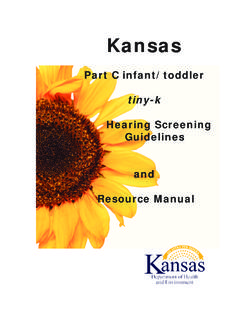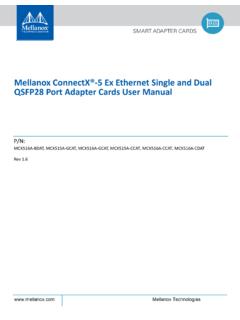Transcription of Chapter 5. MONITORING AND EVALUATION - UNICEF
1 UNICEF , Programme Policy and Procedures Manual: Programme Operations, UNICEF , New York, Revised May 2003, pp. 109-120. Chapter 5. MONITORING AND EVALUATION . 1. MONITORING and EVALUATION (M&E) are integral and individually distinct parts of programme preparation and implementation. They are critical tools for forward-looking strategic positioning, organisational learning and for sound management. 2. This Chapter provides an overview of key concepts, and details the MONITORING and EVALUATION responsibilities of Country Offices, Regional Offices and others. While this and preceding chapters focus on basic description of MONITORING and EVALUATION activities that CO are expected to undertake, more detailed explanation on practical aspects of managing MONITORING and EVALUATION activities can be found in the UNICEF MONITORING and EVALUATION Training Resource as well as in the series EVALUATION Technical Notes.
2 Section 1. Key Conceptual Issues 3. As a basis for understanding MONITORING and EVALUATION responsibilities in programming, this section provides an overview of general concepts, clarifies definitions and explains UNICEF 's position on the current evolution of concepts, as necessary. Situating MONITORING and EVALUATION as oversight mechanisms 4. Both MONITORING and EVALUATION are meant to influence decision-making, including decisions to improve, reorient or discontinue the evaluated intervention or policy; decisions about wider organisational strategies or management structures; and decisions by national and international policy makers and funding agencies. 5. Inspection, audit, MONITORING , EVALUATION and research functions are understood as different oversight activities situated along a scale (see Figure ).
3 At one extreme, inspection can best be understood as a control function. At the other extreme, research is meant to generate knowledge. Country Programme performance MONITORING and EVALUATION are situated in the middle. While all activities represented in Diagram are clearly inter-related, it is also important to see the distinctions. MONITORING 6. There are two kinds of MONITORING : Situation MONITORING measures change in a condition or a set of conditions or lack of change. MONITORING the situation of children and women is necessary when trying to draw conclusions about the impact of programmes or policies. It also includes MONITORING of the wider context, such as early warning MONITORING , or MONITORING of socio-economic trends and the country's wider policy, economic or institutional context.
4 Figure Oversight activities Line Accountability Performance MONITORING measures progress in achieving specific objectives and results in relation to an implementation plan whether for programmes, projects, strategies, and activities. EVALUATION 7. EVALUATION attempts to determine as systematically and objectively as possible the worth or significance of an intervention, strategy or policy. The appraisal of worth or significance is guided by key criteria discussed below. EVALUATION findings should be credible, and be able to influence decision-making by programme partners on the basis of lessons learned. For the EVALUATION process to be objective', it needs to achieve a balanced analysis, recognise bias and reconcile perspectives of different stakeholders (including intended beneficiaries) through the use of different sources and methods.
5 8. An EVALUATION report should include the following: Findings and evidence factual statements that include description and measurement;. Conclusions corresponding to the synthesis and analysis of findings;. Recommendations what should be done, in the future and in a specific situation; and, where possible, Lessons learned corresponding to conclusions that can be generalised beyond the specific case, including lessons that are of broad relevance within the country, regionally, or globally to UNICEF or the international community. Lessons can include generalised conclusions about causal relations (what happens) and generalised normative conclusions (how an intervention should be carried out). Lessons can also be generated through other, less formal evaluative activities. 9. It is important to note that many reviews are in effect evaluations, providing an assessment of worth or significance, using EVALUATION criteria and yielding recommendations and lessons.
6 An example of this is the UNICEF Mid-Term Review. Audits 10. Audits generally assess the soundness, adequacy and application of systems, procedures and related internal controls. Audits encompass compliance of resource transactions, analysis of the operational efficiency and economy with which resources are used and the analysis of the management of programmes and programme activities. (ref. E/ICEF/2001/ ). 11. At country level, Programme Audits may identify the major internal and external risks to the achievement of the programme objectives, and weigh the effectiveness of the actions taken by the UNICEF Representative and CMT to manage those risks and maximise programme achievements. Thus they may overlap somewhat with EVALUATION . However they do not generally examine the relevance or impact of a programme.
7 A Programme Management Audit Self- Assessment Tool is contained in Chapter 6. Research and studies 12. There is no clear separating line between research, studies and evaluations. All must meet quality standards. Choices of scope, model, methods, process and degree of precision must be consistent with the questions that the EVALUATION , study or research is intending to answer. 13. In the simplest terms, an EVALUATION focuses on a particular intervention or set of interventions, and culminates in an analysis and recommendations specific to the evaluated intervention(s). Research and studies tend to address a broader range of questions sometimes dealing with conditions or causal factors outside of the assisted programme but should still serve as a reference for programme design.
8 A Situation Analysis or CCA thus fall within the broader category of "research and study". 14. "Operational" or "action-oriented" research helps to provide background information, or to test parts of the programme design. It often takes the form of intervention trials ( Approaches to Caring for Children Orphaned by AIDS and other Vulnerable Children Comparing six Models of Orphans Care, South Africa 2001). While not a substitute for EVALUATION , such research can be useful for improving programme design and implementing modalities. EVALUATION criteria 15. A set of widely shared EVALUATION criteria should guide the appraisal of any intervention or policy (see Figure ). These are: Relevance What is the value of the intervention in relation to other primary stakeholders'. needs, national priorities, national and international partners' policies (including the Millennium Development Goals, National Development Plans, PRSPs and SWAPs), and global references such as human rights, humanitarian law and humanitarian principles, the CRC and CEDAW?
9 For UNICEF , what is the relevance in relation to the Mission Statement, the MTSP and the Human Rights based Approach to Programming? These global standards serve as a reference in evaluating both the processes through which results are achieved and the results themselves, be they intended or unintended. Efficiency Does the programme use the resources in the most economical manner to achieve its objectives? Effectiveness Is the activity achieving satisfactory results in relation to stated objectives? Impact What are the results of the intervention - intended and unintended, positive and negative - including the social, economic, environmental effects on individuals, communities and institutions? Sustainability Are the activities and their impact likely to continue when external support is withdrawn, and will it be more widely replicated or adapted?
10 Figure EVALUATION Criteria in relation to programme logic GOAL/ IMPACT RELEVANCE. INTENDED. IMPACT Intended Whether people Improved Reduction in water still regard health related diseases water/ hygiene Increased working top priority EFFECTIVE capacity compared with OBJECTIVE/ -NESS irrigation INTENDED. Unintended for food SUSTAIN- OUTCOME Water Conflicts production ABILITY. Improved consumption regarding hygiene ownership of wells People's Latrines in use resources, OUTPUTS EFFICIENCY. motivation, Under-standing and ability to Water supplies # of latrines, ampaigns of hygiene maintain in relation to plans facilities and Demo latrines Quality of outputs improved Costs per unit hygiene in the Health compared with future campaigns standard INPUTS. Equipment Personnel Funds 16.
















